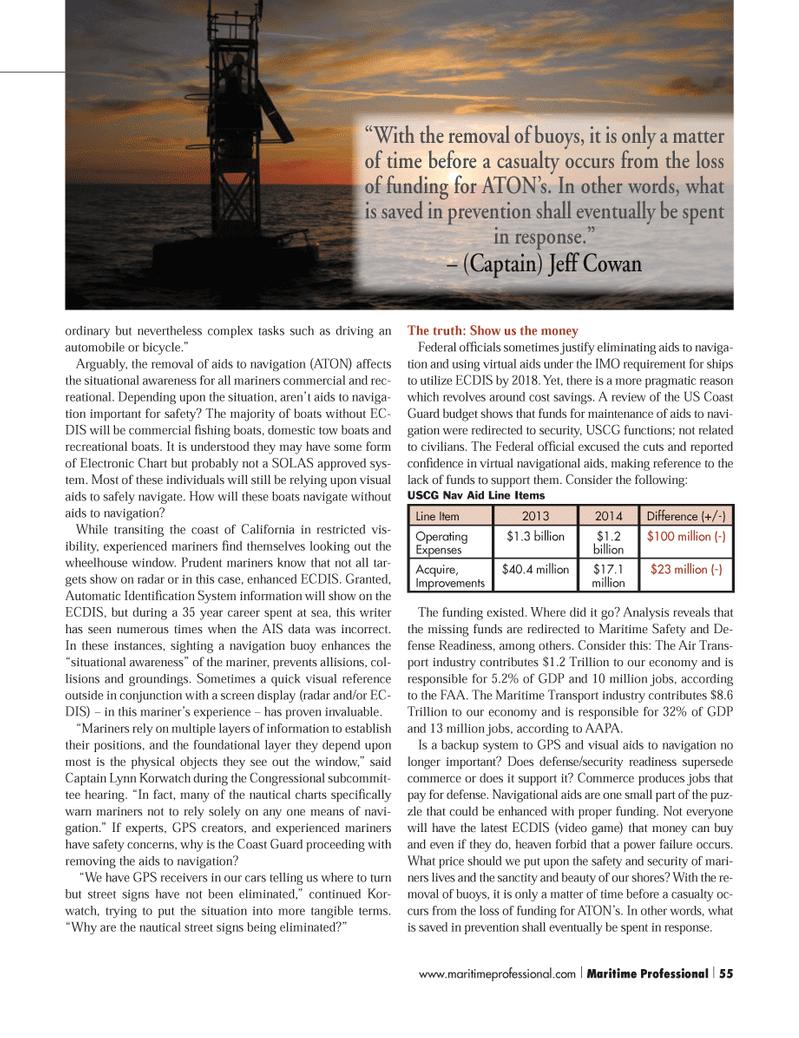
Page 55: of Maritime Logistics Professional Magazine (Q2 2014)
Maritime Risk & Shipping Finance
Read this page in Pdf, Flash or Html5 edition of Q2 2014 Maritime Logistics Professional Magazine
ordinary but nevertheless complex tasks such as driving an automobile or bicycle.”
Arguably, the removal of aids to navigation (ATON) affects the situational awareness for all mariners commercial and rec- reational. Depending upon the situation, aren’t aids to naviga- tion important for safety? The majority of boats without EC-
DIS will be commercial fi shing boats, domestic tow boats and recreational boats. It is understood they may have some form of Electronic Chart but probably not a SOLAS approved sys- tem. Most of these individuals will still be relying upon visual aids to safely navigate. How will these boats navigate without aids to navigation?
While transiting the coast of California in restricted vis- ibility, experienced mariners fi nd themselves looking out the wheelhouse window. Prudent mariners know that not all tar- gets show on radar or in this case, enhanced ECDIS. Granted,
Automatic Identifi cation System information will show on the
ECDIS, but during a 35 year career spent at sea, this writer has seen numerous times when the AIS data was incorrect.
In these instances, sighting a navigation buoy enhances the “situational awareness” of the mariner, prevents allisions, col- lisions and groundings. Sometimes a quick visual reference outside in conjunction with a screen display (radar and/or EC-
DIS) – in this mariner’s experience – has proven invaluable. “Mariners rely on multiple layers of information to establish their positions, and the foundational layer they depend upon most is the physical objects they see out the window,” said
Captain Lynn Korwatch during the Congressional subcommit- tee hearing. “In fact, many of the nautical charts specifi cally warn mariners not to rely solely on any one means of navi- gation.” If experts, GPS creators, and experienced mariners have safety concerns, why is the Coast Guard proceeding with removing the aids to navigation? “We have GPS receivers in our cars telling us where to turn but street signs have not been eliminated,” continued Kor- watch, trying to put the situation into more tangible terms. “Why are the nautical street signs being eliminated?”
The truth: Show us the money
Federal offi cials sometimes justify eliminating aids to naviga- tion and using virtual aids under the IMO requirement for ships to utilize ECDIS by 2018. Yet, there is a more pragmatic reason which revolves around cost savings. A review of the US Coast
Guard budget shows that funds for maintenance of aids to navi- gation were redirected to security, USCG functions; not related to civilians. The Federal offi cial excused the cuts and reported confi dence in virtual navigational aids, making reference to the lack of funds to support them. Consider the following:
The funding existed. Where did it go? Analysis reveals that the missing funds are redirected to Maritime Safety and De- fense Readiness, among others. Consider this: The Air Trans- port industry contributes $1.2 Trillion to our economy and is responsible for 5.2% of GDP and 10 million jobs, according to the FAA. The Maritime Transport industry contributes $8.6
Trillion to our economy and is responsible for 32% of GDP and 13 million jobs, according to AAPA.
Is a backup system to GPS and visual aids to navigation no longer important? Does defense/security readiness supersede commerce or does it support it? Commerce produces jobs that pay for defense. Navigational aids are one small part of the puz- zle that could be enhanced with proper funding. Not everyone will have the latest ECDIS (video game) that money can buy and even if they do, heaven forbid that a power failure occurs.
What price should we put upon the safety and security of mari- ners lives and the sanctity and beauty of our shores? With the re- moval of buoys, it is only a matter of time before a casualty oc- curs from the loss of funding for ATON’s. In other words, what is saved in prevention shall eventually be spent in response.
Line Item 2013 2014 Difference (+/-)
Operating
Expenses $1.3 billion $1.2 billion $100 million (-)
Acquire,
Improvements $40.4 million $17.1 million $23 million (-)
USCG Nav Aid Line Items “With the removal of buoys, it is only a matter of time before a casualty occurs from the loss of funding for ATON’s. In other words, what is saved in prevention shall eventually be spent in response.” – (Captain) Jeff Cowan www.maritimeprofessional.com | Maritime Professional | 55 50-63 Q2 MP2014.indd 55 5/16/2014 3:01:30 PM

 54
54

 56
56
